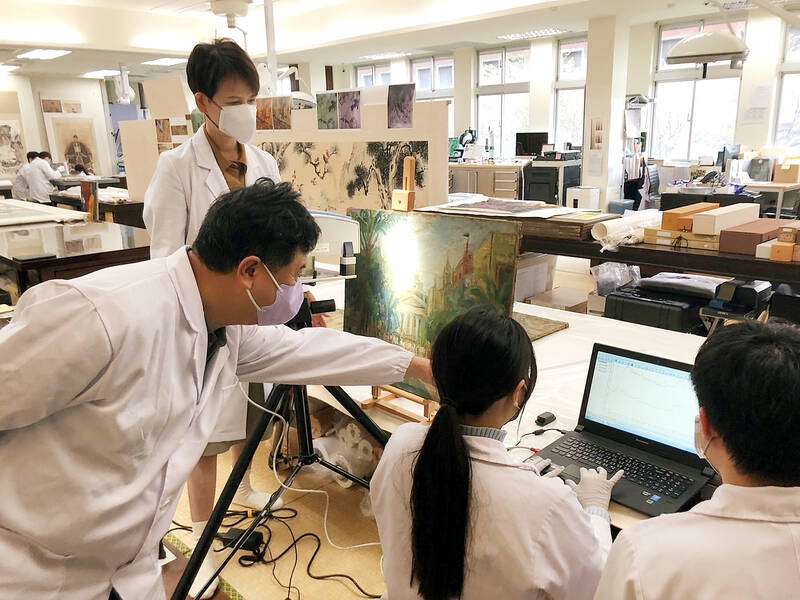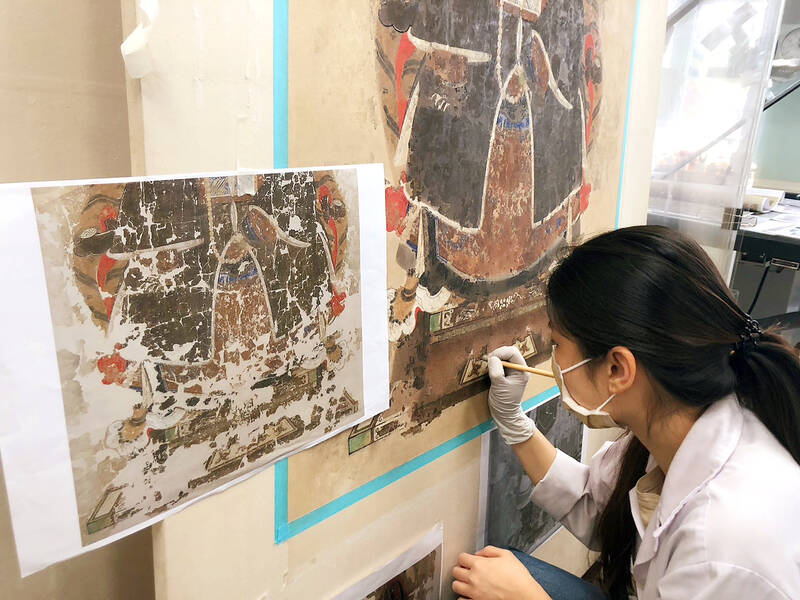The Research Center for Conservation of Cultural Relics at National Taiwan Normal University yesterday for the first time revealed its techniques that have revived countless artworks and priceless artifacts.
The center has for 12 years specialized in assessing, restoring and conserving damaged paintings and other cultural relics to their original splendor, thereby also preserving their value, director Chang Yuan-feng (張元鳳) told reporters.
Collectors have come to the center to restore paintings by famous artists such as Pablo Picasso and Pierre-Auguste Renoir, Chang said.

Photo: Rachel Lin, Taipei Times
Center conservators have also worked on the invaluable Juyan Hanjian (居延漢簡) wooden slip texts dating from the Han Dynasty, family portraits from the Qing Dynasty, historical government documents and national treasures, she said.
Nearly 1,000 works by Taiwanese painters have been restored by the center’s experts, including paintings by Chen Cheng-po (陳澄波), Chen Chin (陳進), Kuo Hsueh-hu (郭雪湖), Lin Yu-shan (林玉山), Chang Dai-chien (張大千) and Pu Hsin-yu (溥心畬), she added.
Their work extends beyond the two-dimensional, as the center has treated and reproduced a bust of the Japanese politician Teijiro Yamamoto by celebrated Taiwanese sculptor Huang Tu-shui (黃土水) held by the Sado City Government in Japan, Chang said.

Photo: Rachel Lin, Taipei Times
Reporters were yesterday allowed inside the center’s workshop, all 100 ping (330.6m2) of which are climate-controlled and protected by a dual security system, and illuminated by ultraviolet-free lights.
When a piece comes in for restoration, after checking for damage, conservators and graduate students carefully remove the grime that makes the artwork look dull and mottled.
Using a piece she restored by Chang Dai-chien as an example, senior conservator Pan Yi-ling (潘怡伶) said that extreme care is taken during the initial inspection.
Doctorate candidate Kuo Ya-chieh (郭雅倢) said that her team has been working on restoring just the bottom half a large Qing-era ancestor portrait for two years.
Restoration work can settle a person’s emotions and slow down time, she said.
A Raman spectrometer is used to ascertain an artwork’s chemical makeup without damaging it, senior scientist Lin Cheng-huang (林震煌) said.
A team at the center has been using infrared light and Raman spectroscopy to collect reference spectral data on pigments, becoming the only university research team in Asia to contribute to the international Infrared & Raman Users Group database, he said.
The center has also maintained an extended working relationship with the Tokyo University of the Arts and Japanese alliance for the restoration of national treasures, he added.
For the first time this year, the center is opening registrations for its two-year program on conservation and restoration to students from other universities with the cooperation of the Ministry of Culture, the school said.
Undergraduates from National Taiwan Normal University, as well as National Taiwan University and the National Taiwan University of Science and Technology, who are interested in conservation can apply online until Tuesday next week.

An essay competition jointly organized by a local writing society and a publisher affiliated with the Chinese Communist Party (CCP) might have contravened the Act Governing Relations Between the People of the Taiwan Area and the Mainland Area (臺灣地區與大陸地區人民關係條例), the Mainland Affairs Council (MAC) said on Thursday. “In this case, the partner organization is clearly an agency under the CCP’s Fujian Provincial Committee,” MAC Deputy Minister and spokesperson Liang Wen-chieh (梁文傑) said at a news briefing in Taipei. “It also involves bringing Taiwanese students to China with all-expenses-paid arrangements to attend award ceremonies and camps,” Liang said. Those two “characteristics” are typically sufficient

A magnitude 5.9 earthquake that struck about 33km off the coast of Hualien City was the "main shock" in a series of quakes in the area, with aftershocks expected over the next three days, the Central Weather Administration (CWA) said yesterday. Prior to the magnitude 5.9 quake shaking most of Taiwan at 6:53pm yesterday, six other earthquakes stronger than a magnitude of 4, starting with a magnitude 5.5 quake at 6:09pm, occurred in the area. CWA Seismological Center Director Wu Chien-fu (吳健富) confirmed that the quakes were all part of the same series and that the magnitude 5.5 temblor was

The brilliant blue waters, thick foliage and bucolic atmosphere on this seemingly idyllic archipelago deep in the Pacific Ocean belie the key role it now plays in a titanic geopolitical struggle. Palau is again on the front line as China, and the US and its allies prepare their forces in an intensifying contest for control over the Asia-Pacific region. The democratic nation of just 17,000 people hosts US-controlled airstrips and soon-to-be-completed radar installations that the US military describes as “critical” to monitoring vast swathes of water and airspace. It is also a key piece of the second island chain, a string of

The Central Weather Administration has issued a heat alert for southeastern Taiwan, warning of temperatures as high as 36°C today, while alerting some coastal areas of strong winds later in the day. Kaohsiung’s Neimen District (內門) and Pingtung County’s Neipu Township (內埔) are under an orange heat alert, which warns of temperatures as high as 36°C for three consecutive days, the CWA said, citing southwest winds. The heat would also extend to Tainan’s Nansi (楠西) and Yujing (玉井) districts, as well as Pingtung’s Gaoshu (高樹), Yanpu (鹽埔) and Majia (瑪家) townships, it said, forecasting highs of up to 36°C in those areas